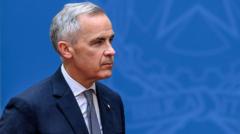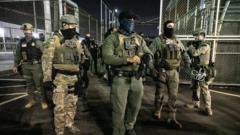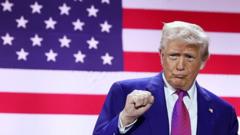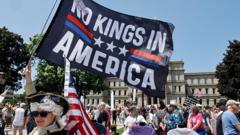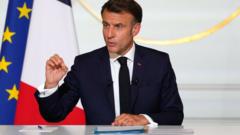The election is crucial amid President Trump's trade threats, challenging the established political landscape in Canada.
**Canada's Election Day: Key Moments and Shifting Dynamics Amidst Global Uncertainty**

**Canada's Election Day: Key Moments and Shifting Dynamics Amidst Global Uncertainty**
Canadians head to the polls as economic challenges and international tensions shape voter priorities.
---
Canadians are casting their votes in what has emerged as a pivotal election, set against the backdrop of President Trump's trade conflicts and pressing economic concerns. The latest opinion polls have indicated a tight race between the Liberal Party, helmed by recently appointed Prime Minister Mark Carney, and the Conservative Party led by Pierre Poilievre. This election is not just about selecting a new leader; it’s about determining the direction Canada will take in response to growing international pressures and domestic issues.
Three additional parties—the New Democratic Party (NDP), the Green Party, and the Bloc Quebecois—are also contesting, although they are expected to secure fewer seats. Just months ago, the Conservatives enjoyed a commanding lead in polls, but the resignation of former Prime Minister Justin Trudeau and the looming threats from the U.S. have shifted the political landscape significantly. The Liberal Party, now viewed as better equipped to manage relations with the U.S., has gained traction in recent weeks.
In Canada's parliamentary system, citizens elect representatives for their electoral districts, with the party that secures the most seats ultimately forming the government. There are 343 seats in the House of Commons; thus, the leader with the most parliamentary seats will assume the role of prime minister.
Mark Carney, at 60 years old, is a former central banker with a reputation for navigating complex economic landscapes, promising to strengthen Canada’s defenses against Trump's policies. Conversely, Pierre Poilievre, 45, promotes a conservative agenda advocating for deregulation and reduced federal oversight, which evokes comparisons to Trump's administration. His challengers accuse him of aligning too closely with a president seen as antagonistic to Canadian interests.
As the clock ticks down, polling stations across Canada's six time zones remain active until 9:30 p.m. Eastern time. Ballots are counted manually, and early results are anticipated by late evening, promising a night filled with crucial updates and potential surprises in this closely watched election.
Beyond the leadership tussle, economic strains have prominently influenced the election narrative. Voters are particularly concerned about Canada's steep housing crisis, escalating costs of living, and the impacts of Trump's tariffs on daily expenses. Carney and Poilievre have both vowed to address these issues head-on, proposing tax cuts and financial relief measures to assist struggling Canadians.
As early results start trickling in, the nation awaits to see how these dynamics will reshape its political landscape amidst ongoing uncertainty and global challenges. Moving forward, this election offers a critical lens not only on domestic governance but also on Canada's role in a changing world.
Canadians are casting their votes in what has emerged as a pivotal election, set against the backdrop of President Trump's trade conflicts and pressing economic concerns. The latest opinion polls have indicated a tight race between the Liberal Party, helmed by recently appointed Prime Minister Mark Carney, and the Conservative Party led by Pierre Poilievre. This election is not just about selecting a new leader; it’s about determining the direction Canada will take in response to growing international pressures and domestic issues.
Three additional parties—the New Democratic Party (NDP), the Green Party, and the Bloc Quebecois—are also contesting, although they are expected to secure fewer seats. Just months ago, the Conservatives enjoyed a commanding lead in polls, but the resignation of former Prime Minister Justin Trudeau and the looming threats from the U.S. have shifted the political landscape significantly. The Liberal Party, now viewed as better equipped to manage relations with the U.S., has gained traction in recent weeks.
In Canada's parliamentary system, citizens elect representatives for their electoral districts, with the party that secures the most seats ultimately forming the government. There are 343 seats in the House of Commons; thus, the leader with the most parliamentary seats will assume the role of prime minister.
Mark Carney, at 60 years old, is a former central banker with a reputation for navigating complex economic landscapes, promising to strengthen Canada’s defenses against Trump's policies. Conversely, Pierre Poilievre, 45, promotes a conservative agenda advocating for deregulation and reduced federal oversight, which evokes comparisons to Trump's administration. His challengers accuse him of aligning too closely with a president seen as antagonistic to Canadian interests.
As the clock ticks down, polling stations across Canada's six time zones remain active until 9:30 p.m. Eastern time. Ballots are counted manually, and early results are anticipated by late evening, promising a night filled with crucial updates and potential surprises in this closely watched election.
Beyond the leadership tussle, economic strains have prominently influenced the election narrative. Voters are particularly concerned about Canada's steep housing crisis, escalating costs of living, and the impacts of Trump's tariffs on daily expenses. Carney and Poilievre have both vowed to address these issues head-on, proposing tax cuts and financial relief measures to assist struggling Canadians.
As early results start trickling in, the nation awaits to see how these dynamics will reshape its political landscape amidst ongoing uncertainty and global challenges. Moving forward, this election offers a critical lens not only on domestic governance but also on Canada's role in a changing world.









